Moscow School of Robotics really exists. And she is in Yasenevo
On Friday, at the invitation of a friend, I visited the school of robots for the first time and went to Zelenograd to visit the very factory Angstrom and go to the cybernetics laboratory neurolabs.ru. As a result, I composed my opinion about local affairs and want to share it with you, Habr.
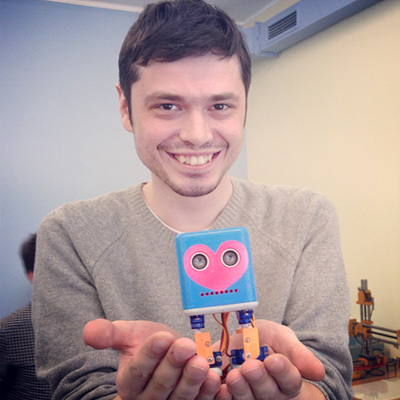
A new world is always going to fanatic on the knee. Jobs and Wozniak believed very much in personal computers and began to assemble them in their garage in 197, the year - today Apple is the largest company in the world. Yes, it's past, count 40 years, but the spirit of "garage enthusiasm" has not disappeared.
')
Now imagine that the same fans of their business are sitting "in the garage" in modern Moscow, and with burning eyes, are collecting "personal robots." Now it's just engineers with a soldering iron, but what will happen in twenty years?
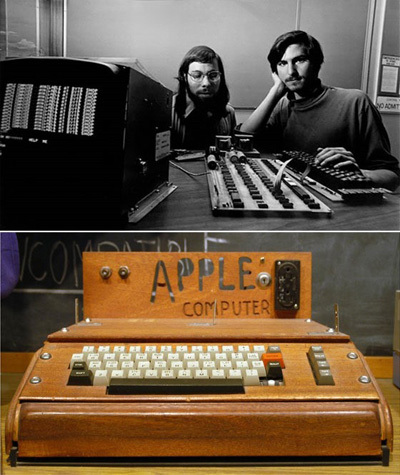
The personalities turned our world around and created a hyperinformation society, where everyone had instant access to all the knowledge of humanity. And now imagine that in 10 years they will start to make anthropomorphic robots with artificial intelligence in the same way.
Each person will have several mechanical servants who can replace us in almost everything: go to the store, make dinner, write the program code, look after the children, read and retell you a book, and generally perform any routine work. In case of emergency, the robot will not hesitate to give life for a person, but the most important thing is that you will not have to work anymore - only creative tasks will remain. All the rest will be done by robots - things will become practically free, everything will cost exactly as much as the idea of any thing + energy for its production.

But this is not the main thing. The main thing is that robots will change the person himself - for the first time we will get the opportunity to look at ourselves. This will drastically change both culture and society. Well, for example, now few people understand that laughter is a physiological reaction to the logical paradox in the chain of thought, the physical protection of consciousness. Even worse with an understanding of the essence of religion or mass psychology.
With the advent of robots, all of these, today available only to intellectuals, themes will be obvious even to children. But not at once. On the implementation of the staff, it took almost 20 years. They took root in a year, but learning to use them, culturally grow on the Internet to the stage of quiet conversation with each other, people could only by the mid-2000s.
Imagine a school where elementary students communicate with robots. And now, imagine that they collect them. It sounds pretty fantastic, but not for the Moscow school in Yasenevo.

Regular schoolchildren make robots here: they design, print the parts, solder the boards and program the behavior. I do not know what could be cooler in school.
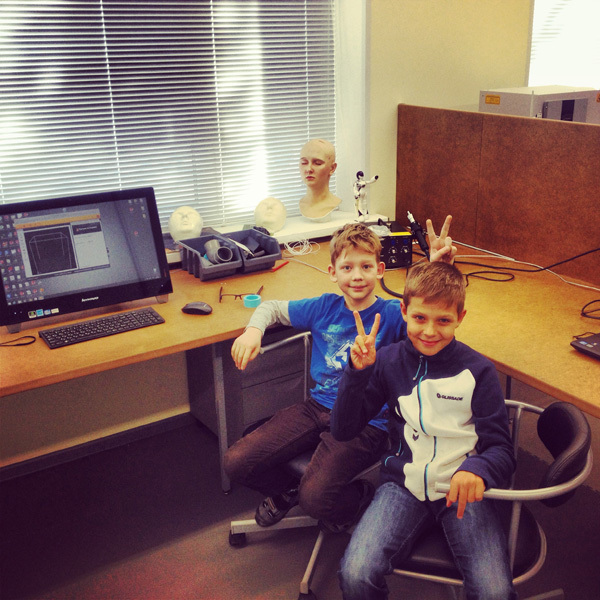
Serega and Nikita are classmates and go here every Tuesday and Thursday, they make a project of a desktop turret with laser guidance. Seriously envy boys!
Already this photo shows how much children like to attend classes. In contrast to the usual lessons of informatics, even programming is evident here - I went around the algorithm of the movement and the robot immediately began to move.

3d printer is broken, and the guys are asked to move them to the queue for another. They have an urgent situation - on the prodlenka they broke the wheel of their first project - a radio-controlled typewriter.

In the classrooms, instead of the usual desks and chalk for the blackboard, soldering irons are scattered around. Everyone is sitting at the laptops, on the screens of which are drawings. Amazing symbiosis of a school office and a real workshop. If you look closely, on the right and on the left there are two disassembled wheels.

Next to the classes - a shop with machines, judging by computer control, sharpen on them no more difficult than printing on a 3d printer.
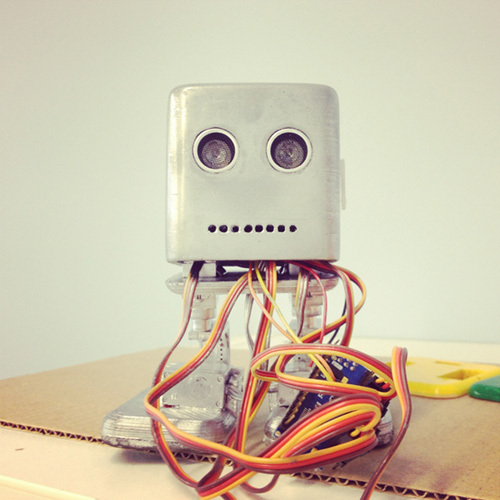
Stereo camera and a pair of legs. On these kids they work out “swarm beginning” and algorithms of interaction of robots in groups. In general, this is a standard educational robot in school, they are called Robots.
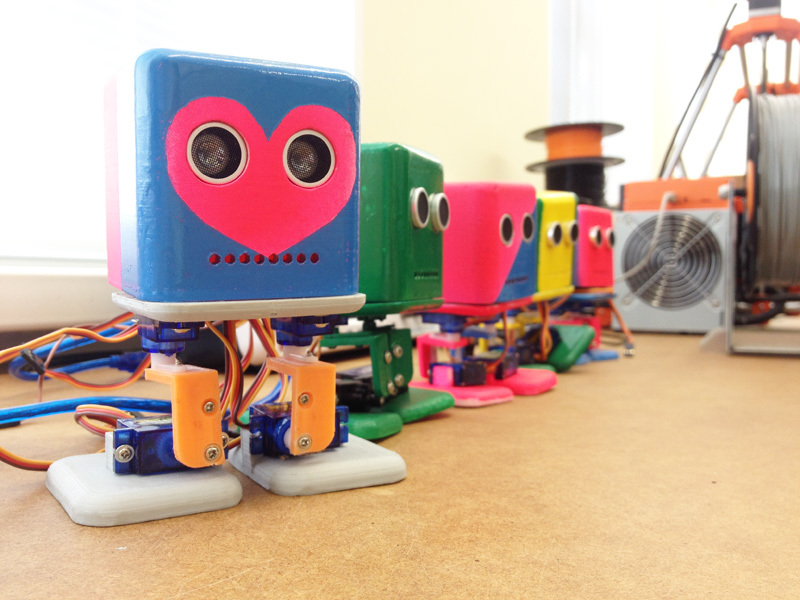
The beans are grouped for a reason, they are preparing to connect to a common network - they will all be controlled by an operator in a helmet who reads mental orders.
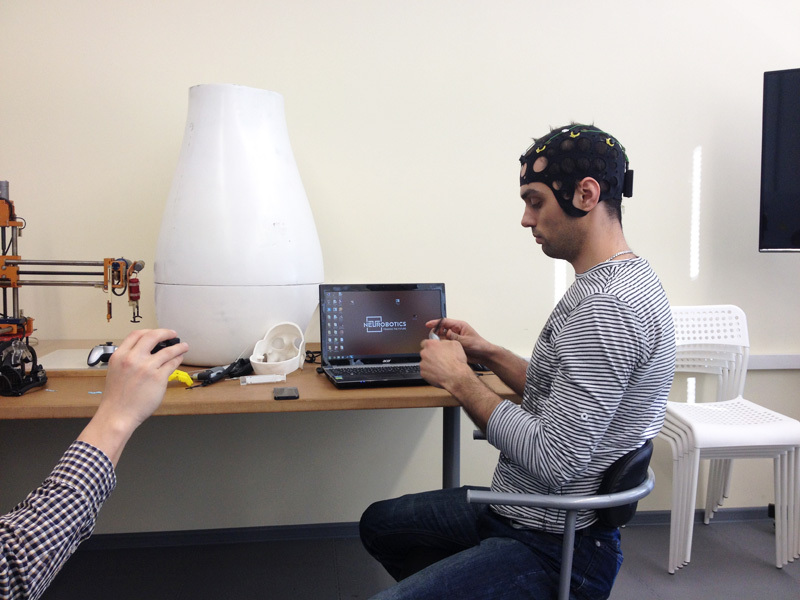
A helmet does not work as easily as it may seem at first glance - it cannot take a concrete thought “to the right” - it can only mark a specific mental state of the brain. You set up in the program four or six of any states and the system begins to understand them. In fact, your brain should produce a certain graph on the monitor - then the machine will recognize it.
Of course, in practice, everything is more complicated, and we are talking about training management of your brain. An experienced operator acquires the skill of controlling his psychophysical state and emotional background. Moreover, unlike the ordinary person, who often takes a long time to take control of his emotions, the operator does it instantly.
As a test, you can go through the maze, mentally moving the red pixel. From the outside, it looks strange and fascinating - the box really moves, receiving telepathic signals.
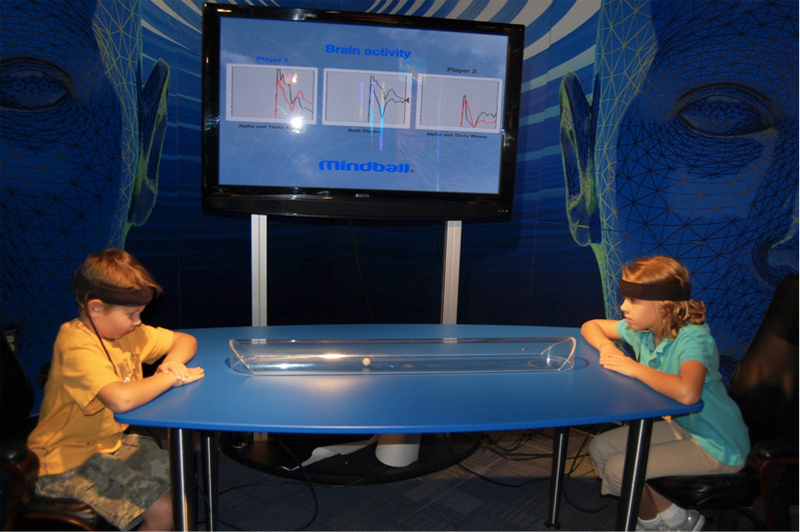
Without the skills to play "brainwalk" is very hard - the ball moves here depending on how well and for a long time you can keep your brain in a certain state. The one who holds more is moving the ball. All children in school begin with this game, as with the simplest simulator. Then you can work with the helmet.

The center is owned by the company Neurobotics , for which the Moscow government has agreed to buy machines and make room for the laboratory, provided that schoolchildren can go to it two days a week. The company received, in the person of schoolchildren, an army of fanatical helpers, and those, in turn, had a real opportunity to create robots. The main activity of Neurobotics is the production of anthropomorphic robots.
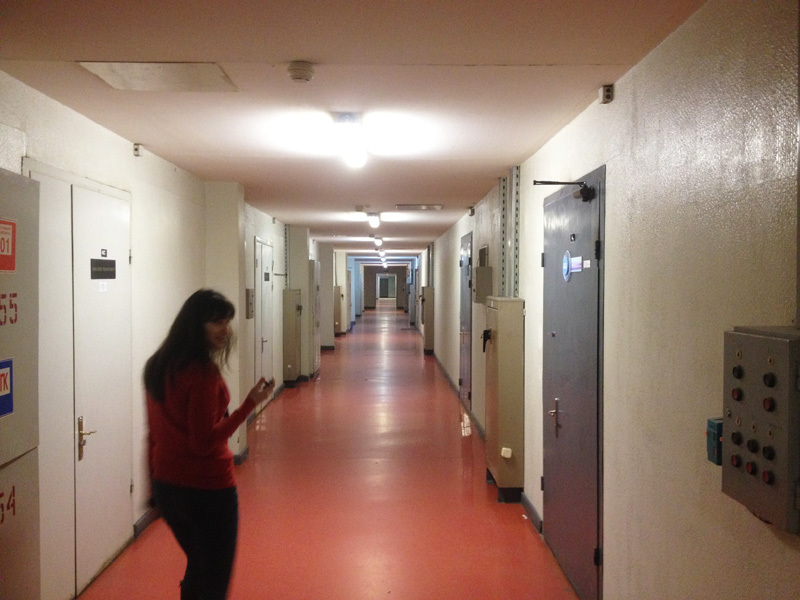
If robots are produced and assembled at school, they are designed at Anggsterm’s Zelenograd plant - there are endless labyrinths, an office and workshops.
But before entering the laboratory, a lyrical digression is required.
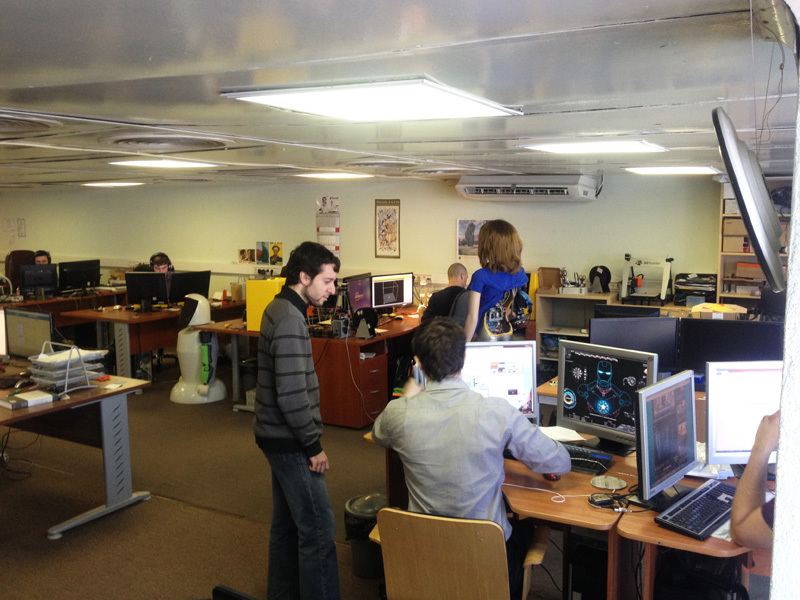
It works mainly people from Bauman. Their goal is very simple - to bring their technology to the conveyor production of robots, completely similar to humans and the price (attention!), Not more than 1 million rubles. Robots will understand voice commands and make decisions on their own as they are executed.

The company's founder, biophysicist doctor Vladimir Konyshev, describes the development of robotics as a high school 12 years old, according to his estimates, the company is strictly in the third grade. Why in the third? Next to it is a prototype pneumatic arm, this is the third robot of the company.
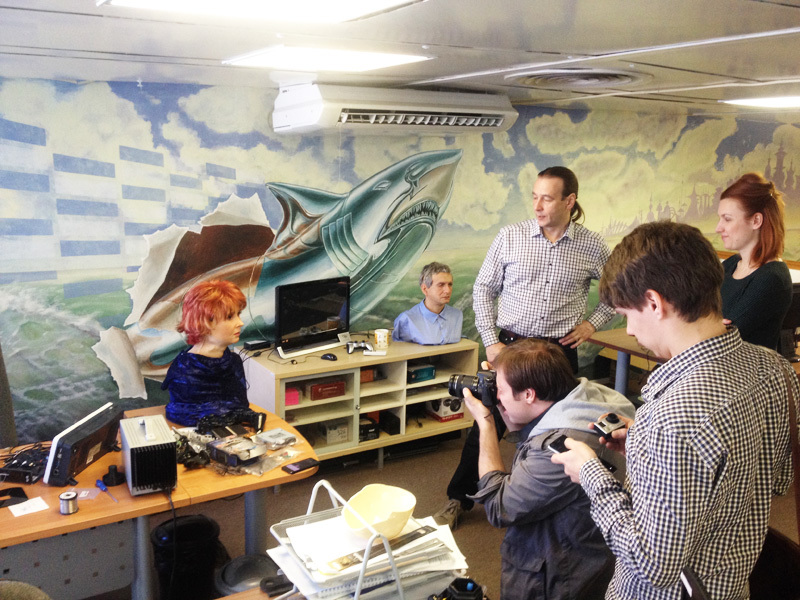
On the left, the very first robot produced by Neurobotics - Alice talking head. He smiles, laughs, talks, but has only eight facial drives, which is enough only for basic emotions.
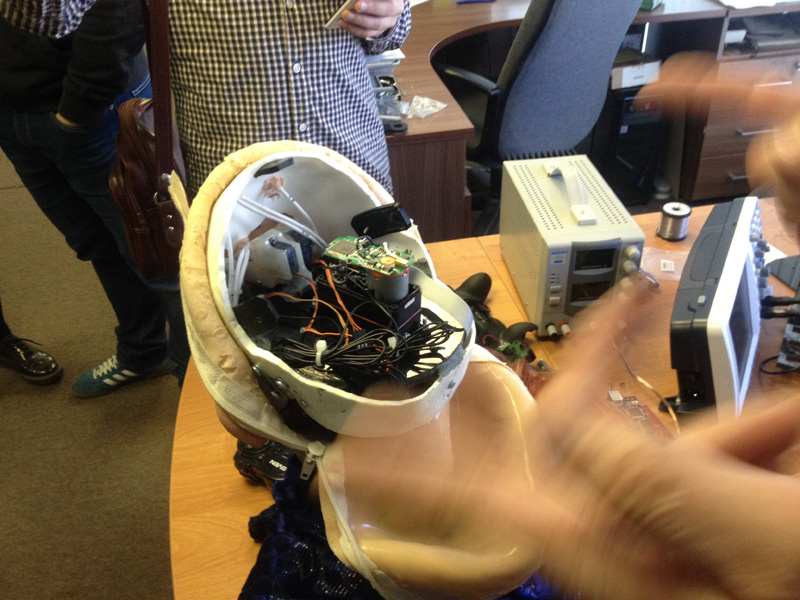
Even the electronics could not be placed in the skull - there are only eight motors, the computer is hidden in the chest.

Another thing is Alex. 18 muscles, reflex blinking and eye control, understands the emotions and speech of the interlocutor. The scalp is no longer detachable, and instead of a wig, hair implanted into the skin. It looks frighteningly natural.

If desired, each muscle is controlled with an ordinary joystick. In essence, this is a simulator for working out software and technologies.
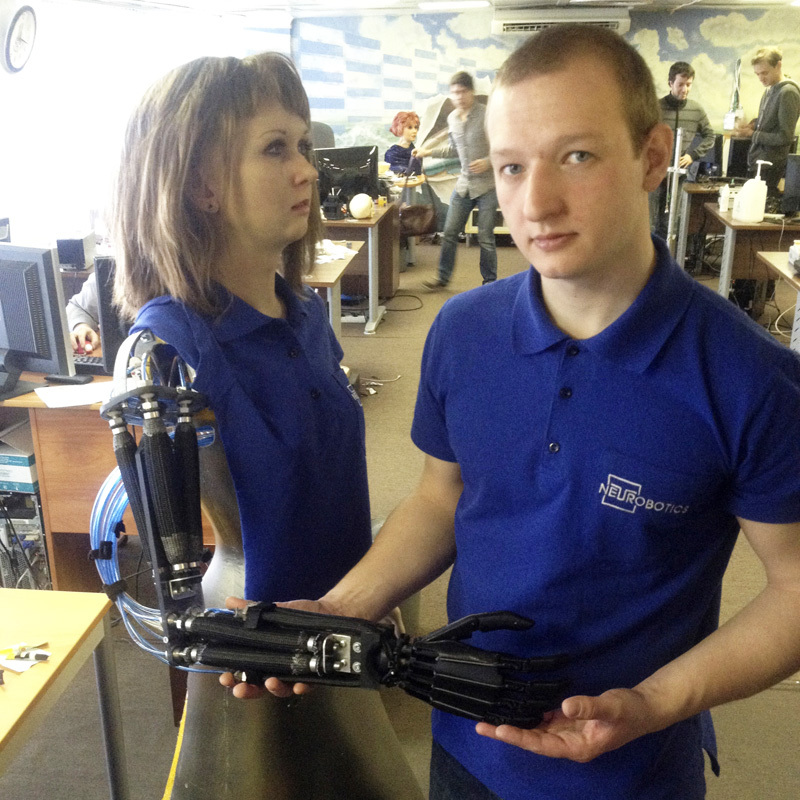
By mechanical hand, it is clear that, in principle, they can already collect something like the Boston Atlas, but this is just an expensive toy - it works from the network and costs Nemer in piece production. The task is to roll back technologies and produce them as cars - for corporations, the army and, above all, for retail.

Here is the head of the Pushkin robot, who will lead the lessons of literature in schools. The skin looks surprisingly well, behaves naturally on the folds and is indistinguishable to the touch from the present - except that it is cold. This is the fourth generation of Neurobotics robots - they are now collecting it with all their might to be able to have time for the opening of the BALL OF ROBOTS exhibition by May 15.
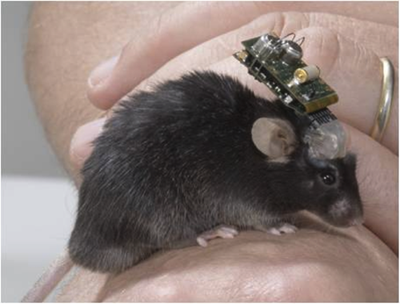
Where does the money come from? Konyshev knowingly graduated from the 2nd Medical University - his specialization is neurophysiology and devices for reading brain states. Neurobotics did not attract any investment and fully covers the costs through the sale of medical devices like Neurologger, which will be installed on rats to monitor their electrical activity in experiments.

Electroencephalography systems are more difficult to use by professional athletes (in the photo, the Olympic medalist in training) to track alpha rhythms. With their help, an athlete learns to independently select and control the state of the brain, and this is very important in competitions where you can’t be nervous.

But the most impressive is the simplest exoskeleton for rehabilitation after a stroke. Paralyzed people wear a hat and mentally move their limbs - an exoskeleton sets them in motion.
Thus, the nerves begin to recover from two sides - from the brain and the motor memory of the limb, and most importantly - the patient comes out of severe depression because of his helplessness and the nerves recover much faster. Very simple and cheap - but it is the most effective way to recover from severe lesions of the nervous system.

A tidbit for any robotics - military orders. Today, all the armies of the world are looking towards robots with interest. Back in 2008, the Russian Foundation for Promising Development sponsored the release of the AR-B00 robot by the Android Technique. It is not difficult to see that the model copies the Japanese ASIMO, which is a dead-end branch of robotics, - rather a toy than a robot. The thing about electric motors is that they are thin and slow; it’s almost useless to use such a device.
Here, by the way, not just “Russian backwardness” - the Boston Atlas is also, in fact, a toy - it is powered from the network by cable and cannot be autonomous, for this you need to change the whole structure.
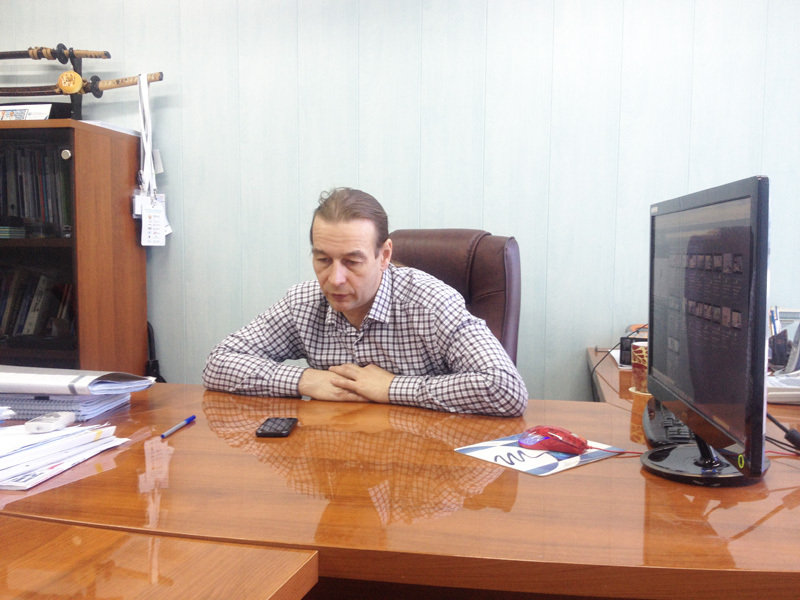
Now Konyshev hopes for a contract from the Ministry of Defense, but not for the production of robots, but for psycho simulators. Vladimir is convinced that in battle conditions, mental control will always win. The meaning of the simulator is to teach the soldier "distributed attention."
The sappers have something similar: they can monitor the whole environment at once. For example, walking through the forest, the sapper instantly notices all the stretch marks, mines and traps, no matter how well they are disguised. An ordinary soldier can also be taught similar skills, and then he will be able to perform a combat task, commanding a pair of armed androids following him. And all this is only thoughts, and then in the background.
All this can be seen and touched at the BALL OF ROBOTS exhibition on May 15 where Robot-Pushkin and a swarm of robots will be shown for the first time. Come, it will be interesting - the list of participants is already impressive!
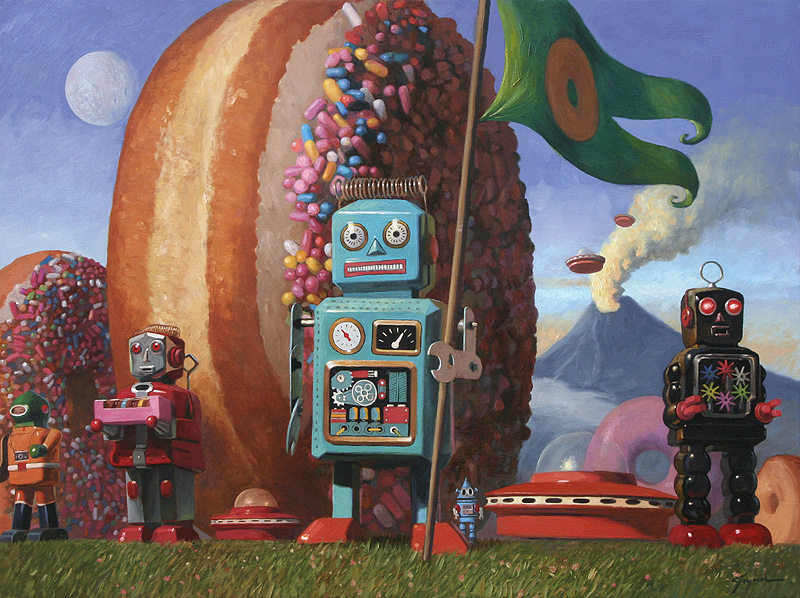
The author of this picture will also come to the Ball of robots.

A new world is always going to fanatic on the knee. Jobs and Wozniak believed very much in personal computers and began to assemble them in their garage in 197, the year - today Apple is the largest company in the world. Yes, it's past, count 40 years, but the spirit of "garage enthusiasm" has not disappeared.
')
Now imagine that the same fans of their business are sitting "in the garage" in modern Moscow, and with burning eyes, are collecting "personal robots." Now it's just engineers with a soldering iron, but what will happen in twenty years?

The personalities turned our world around and created a hyperinformation society, where everyone had instant access to all the knowledge of humanity. And now imagine that in 10 years they will start to make anthropomorphic robots with artificial intelligence in the same way.
Each person will have several mechanical servants who can replace us in almost everything: go to the store, make dinner, write the program code, look after the children, read and retell you a book, and generally perform any routine work. In case of emergency, the robot will not hesitate to give life for a person, but the most important thing is that you will not have to work anymore - only creative tasks will remain. All the rest will be done by robots - things will become practically free, everything will cost exactly as much as the idea of any thing + energy for its production.

But this is not the main thing. The main thing is that robots will change the person himself - for the first time we will get the opportunity to look at ourselves. This will drastically change both culture and society. Well, for example, now few people understand that laughter is a physiological reaction to the logical paradox in the chain of thought, the physical protection of consciousness. Even worse with an understanding of the essence of religion or mass psychology.
With the advent of robots, all of these, today available only to intellectuals, themes will be obvious even to children. But not at once. On the implementation of the staff, it took almost 20 years. They took root in a year, but learning to use them, culturally grow on the Internet to the stage of quiet conversation with each other, people could only by the mid-2000s.
Imagine a school where elementary students communicate with robots. And now, imagine that they collect them. It sounds pretty fantastic, but not for the Moscow school in Yasenevo.

Regular schoolchildren make robots here: they design, print the parts, solder the boards and program the behavior. I do not know what could be cooler in school.

Serega and Nikita are classmates and go here every Tuesday and Thursday, they make a project of a desktop turret with laser guidance. Seriously envy boys!
Already this photo shows how much children like to attend classes. In contrast to the usual lessons of informatics, even programming is evident here - I went around the algorithm of the movement and the robot immediately began to move.

3d printer is broken, and the guys are asked to move them to the queue for another. They have an urgent situation - on the prodlenka they broke the wheel of their first project - a radio-controlled typewriter.

In the classrooms, instead of the usual desks and chalk for the blackboard, soldering irons are scattered around. Everyone is sitting at the laptops, on the screens of which are drawings. Amazing symbiosis of a school office and a real workshop. If you look closely, on the right and on the left there are two disassembled wheels.

Next to the classes - a shop with machines, judging by computer control, sharpen on them no more difficult than printing on a 3d printer.

Stereo camera and a pair of legs. On these kids they work out “swarm beginning” and algorithms of interaction of robots in groups. In general, this is a standard educational robot in school, they are called Robots.

The beans are grouped for a reason, they are preparing to connect to a common network - they will all be controlled by an operator in a helmet who reads mental orders.

A helmet does not work as easily as it may seem at first glance - it cannot take a concrete thought “to the right” - it can only mark a specific mental state of the brain. You set up in the program four or six of any states and the system begins to understand them. In fact, your brain should produce a certain graph on the monitor - then the machine will recognize it.
Of course, in practice, everything is more complicated, and we are talking about training management of your brain. An experienced operator acquires the skill of controlling his psychophysical state and emotional background. Moreover, unlike the ordinary person, who often takes a long time to take control of his emotions, the operator does it instantly.
As a test, you can go through the maze, mentally moving the red pixel. From the outside, it looks strange and fascinating - the box really moves, receiving telepathic signals.

Without the skills to play "brainwalk" is very hard - the ball moves here depending on how well and for a long time you can keep your brain in a certain state. The one who holds more is moving the ball. All children in school begin with this game, as with the simplest simulator. Then you can work with the helmet.

The center is owned by the company Neurobotics , for which the Moscow government has agreed to buy machines and make room for the laboratory, provided that schoolchildren can go to it two days a week. The company received, in the person of schoolchildren, an army of fanatical helpers, and those, in turn, had a real opportunity to create robots. The main activity of Neurobotics is the production of anthropomorphic robots.

If robots are produced and assembled at school, they are designed at Anggsterm’s Zelenograd plant - there are endless labyrinths, an office and workshops.
But before entering the laboratory, a lyrical digression is required.
Modern society does not quite understand what robots are - it seems that this is a hybrid of a toy, a computer and an exoskeleton. But this is a fundamentally new thing that is simply impossible to imagine in our culture.
I will show on analogy with personal computers. Until the mid-80s, many waited for the PC to appear, but represented them as a hybrid of a typewriter and personal archive. Of course, people who worked directly in the field of electronics understood the principle of operation and can be guessed about some of the directions for using cheap cars that will be in private use. But for them it was only small computers, something like a home chemical laboratory for a chemist. So it was served even in the early 80s, when there was a hype around BIS. Those. it was about giant calculators. So thought even the direct authors of the first personok. The planned consumer market of these machines is scientists, then accounting services, office printing houses, etc.
I assure you that the modern concept of robots is just as childish.
It can be said that the person is a combine player, TV and typewriter. It will be an absurdity, an excuse for a person of the 60s and 70s. It can be said that a personalka is a thinking machine, an electronic brain, but this will also be an absurdity, again an apologetic person of the 60-70s. The robot is not a toy-machine and not an artificial person - it is a robot. But the man of the 00-10th is not to understand this.
In fact, personal computers are used as mail systems, as audio and video centers, as desks and libraries. Through computers they play computer games. It turned out that this is not a separate device, but a certain addition to the brain, which extremely expands its communication and analytical skills.
That's the same thing with robots.

It works mainly people from Bauman. Their goal is very simple - to bring their technology to the conveyor production of robots, completely similar to humans and the price (attention!), Not more than 1 million rubles. Robots will understand voice commands and make decisions on their own as they are executed.

The company's founder, biophysicist doctor Vladimir Konyshev, describes the development of robotics as a high school 12 years old, according to his estimates, the company is strictly in the third grade. Why in the third? Next to it is a prototype pneumatic arm, this is the third robot of the company.

On the left, the very first robot produced by Neurobotics - Alice talking head. He smiles, laughs, talks, but has only eight facial drives, which is enough only for basic emotions.

Even the electronics could not be placed in the skull - there are only eight motors, the computer is hidden in the chest.

Another thing is Alex. 18 muscles, reflex blinking and eye control, understands the emotions and speech of the interlocutor. The scalp is no longer detachable, and instead of a wig, hair implanted into the skin. It looks frighteningly natural.

If desired, each muscle is controlled with an ordinary joystick. In essence, this is a simulator for working out software and technologies.

By mechanical hand, it is clear that, in principle, they can already collect something like the Boston Atlas, but this is just an expensive toy - it works from the network and costs Nemer in piece production. The task is to roll back technologies and produce them as cars - for corporations, the army and, above all, for retail.

Here is the head of the Pushkin robot, who will lead the lessons of literature in schools. The skin looks surprisingly well, behaves naturally on the folds and is indistinguishable to the touch from the present - except that it is cold. This is the fourth generation of Neurobotics robots - they are now collecting it with all their might to be able to have time for the opening of the BALL OF ROBOTS exhibition by May 15.

Where does the money come from? Konyshev knowingly graduated from the 2nd Medical University - his specialization is neurophysiology and devices for reading brain states. Neurobotics did not attract any investment and fully covers the costs through the sale of medical devices like Neurologger, which will be installed on rats to monitor their electrical activity in experiments.

Electroencephalography systems are more difficult to use by professional athletes (in the photo, the Olympic medalist in training) to track alpha rhythms. With their help, an athlete learns to independently select and control the state of the brain, and this is very important in competitions where you can’t be nervous.

But the most impressive is the simplest exoskeleton for rehabilitation after a stroke. Paralyzed people wear a hat and mentally move their limbs - an exoskeleton sets them in motion.
Thus, the nerves begin to recover from two sides - from the brain and the motor memory of the limb, and most importantly - the patient comes out of severe depression because of his helplessness and the nerves recover much faster. Very simple and cheap - but it is the most effective way to recover from severe lesions of the nervous system.

A tidbit for any robotics - military orders. Today, all the armies of the world are looking towards robots with interest. Back in 2008, the Russian Foundation for Promising Development sponsored the release of the AR-B00 robot by the Android Technique. It is not difficult to see that the model copies the Japanese ASIMO, which is a dead-end branch of robotics, - rather a toy than a robot. The thing about electric motors is that they are thin and slow; it’s almost useless to use such a device.
Here, by the way, not just “Russian backwardness” - the Boston Atlas is also, in fact, a toy - it is powered from the network by cable and cannot be autonomous, for this you need to change the whole structure.

Now Konyshev hopes for a contract from the Ministry of Defense, but not for the production of robots, but for psycho simulators. Vladimir is convinced that in battle conditions, mental control will always win. The meaning of the simulator is to teach the soldier "distributed attention."
The sappers have something similar: they can monitor the whole environment at once. For example, walking through the forest, the sapper instantly notices all the stretch marks, mines and traps, no matter how well they are disguised. An ordinary soldier can also be taught similar skills, and then he will be able to perform a combat task, commanding a pair of armed androids following him. And all this is only thoughts, and then in the background.
All this can be seen and touched at the BALL OF ROBOTS exhibition on May 15 where Robot-Pushkin and a swarm of robots will be shown for the first time. Come, it will be interesting - the list of participants is already impressive!

The author of this picture will also come to the Ball of robots.
Source: https://habr.com/ru/post/220477/
All Articles
